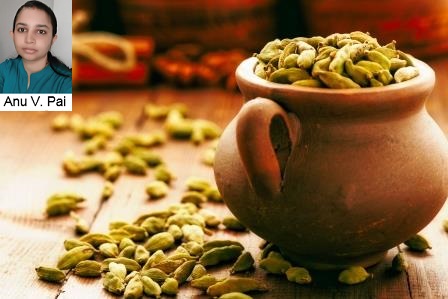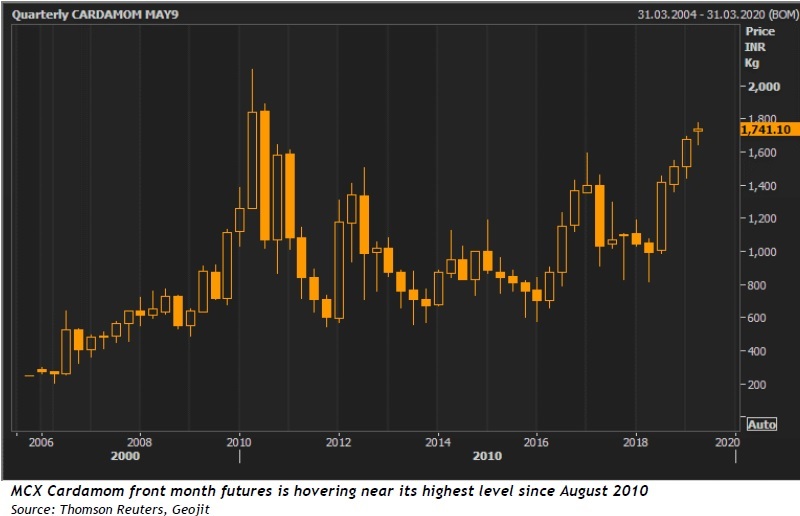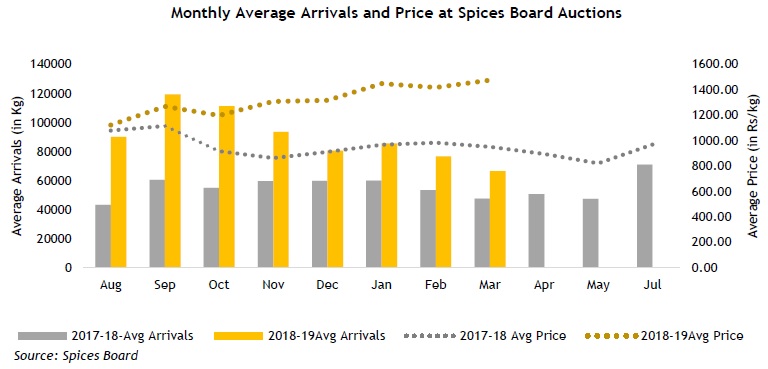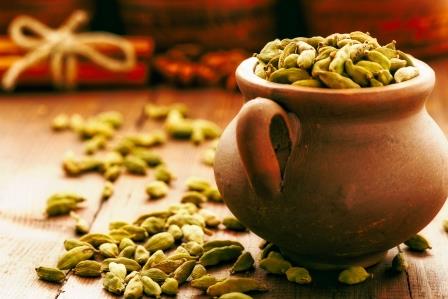 The aromatic spice, cardamom, has breached Rs.1600 a kg in the auctions, while in the futures market it is hovering near its highest level since August 2010.
The aromatic spice, cardamom, has breached Rs.1600 a kg in the auctions, while in the futures market it is hovering near its highest level since August 2010.
Small cardamom, Elettaria cardamomum, also called the Queen of Spices, is considered to be the third most expensive spice after saffron and vanilla. These small but highly priced pods are obtained from a perennial tropical herb plant that belongs to ginger family Zingiberaceae. Cardamom is native to India and is also well cultivated in Guatemala, Nepal, Sri Lanka, Mexico, Thailand and Central America. Guatemala is the world’s largest producer of cardamom followed by India. These two countries together constitute more than 70 percent of the global production. Besides these two major producers, cardamom is grown on small scale in Tanzania, Sri Lanka, El Salvador, Vietnam, Laos, Thailand, Cambodia, Honduras, and Papua and New Guinea.Middle East and South East Asian countries like Indian are the major consumers, constituting more than 60 percent of global cardamom consumption.
India holds a significant position in global cardamom market as it is one of the key producers as well as consumer. In India, Kerala is the top producer of small cardamom followed by Karnataka and Tamil Nadu. In the year 2017-18, total production was estimated to be 20650 tonnes with 18350 tonnes (89%) coming from Kerala, followed by 1450 tonnes (7.0%) from Karnataka and the rest 850 tonnes (4.0%) from Tamil Nadu.
Total area under small cardamom cultivation in the country is estimated to 69330 hectares in the year 2017-18 of which Kerala accounts for 56 percent according to the data released by the Spices Board of India. In Kerala, cardamom is cultivated in seven districts of which Idukki district tops the list. According to Agricultural Statistics 2017-18, of the total area under cardamom cultivation in Kerala, Idukki constitutes 79.75 percent followed by Wayanad with 10.54 percent.
There has been a substantial surge in cardamom prices in the country off late. Since June 2018, the commodity has been exhibiting bullishness. Cardamom price has been steadily rising since then and has climbed to its highest level in more than eight years. In the auctions, price has been rising and daily average prices broke above Rs.1600 a kg in March. In the meantime, there was surge in arrivals compared to last year at the auctions as traders started to off-load stocks.


Concerns over production, unfavorable weather and forecasts of smaller output from Guatemala in the current marketing year of 2018-19 has propelled a rally in this aromatic spice.
Adverse weather in the major cardamom growing regions in India is turning out to be a weighty factor influencing the price of this aromatic spice. The current rally in cardamom began by June 2018 and a sharp jump was witnessed during the month of August, when the main harvesting season begins in Kerala. Since the devastating floods in Kerala during the month of August last year, climatic conditions in the state has been turning out to be detrimental for cardamom production.
Heavy Southwest monsoons and subsequent simultaneous opening of dams had significantly affected agricultural production in the state. Heavy monsoons, floods and landslides in Kerala, the top producer of cardamom in the country, during the commencement of the harvest period damaged plantations. Kerala received 2515.7 mm of rainfall during the Southwest Monsoon season starting from June 1- September 30 in 2018 according to the Indian Meteorological Department. The top cardamom cultivating districts in the state- Idukki received 65 percent excess rainfall, while it was within the normal range for Wayanad. According to the Indian Institute of Spices Research, Idukki and Wayanad, which together accounts for 62 percent of spices cultivation in Kerala, had borne the brunt of weather vagaries with 25755 hectares of cardamom plantation was affected during the floods and estimated crop loss of 6600 tonnes worth Rs.679 crores. It also added that the costs may escalate higher considering the variable and fixed cost inputs, the cost of re-establishing the crop, the long gestation period to attain full bearing etc. Excess rainfall in major small cardamom growing regions in Karnataka like Kodagu, Chikmagalur and Hassan saw decreased production from the state as well.
While the sector was yet to recover from the aftereffects of the floods, there was significant drop in temperatures during the winter months in Kerala, especially in the month of January in the major cardamom growing regions. Frost formation due to fall in temperature to sub-zero levels affected production, buoying the uptrend in cardamom. According to market sources, there was a noticeable drop in production during this period. And now, shortfall of summer rains has added to the worries of production shortage, lifting cardamom prices to its highest level in more than eight years. Generally, it is said that, output expectations for the next harvest season, which starts from August-September in Kerala, depend upon the rains received during the summer. Summer rains/ pre-monsoon showers and South-west monsoon rains during Jun-Jul period are necessary for good yields as growth of new offshoots, flowering and seed formation happens during this period. The Indian Meteorological Department’s data for March 1 to April 10, 2019, Kerala received only 20.8 mm of rainfall with a deficiency of 65 percent. For Idukki and Wayanad deficiency is 75 and 30 percent respectively. According to Skymet, in many of plantation areas such as Vandanmedu, which is classified as A-grade center for cardamom production, rain deficiency is around 40 percent.

Owing to unconducive weather, for the 2018-19 period, the market expectation on production has been lowered, ranging from 40-60 percent compared to last year. Meanwhile, Spices Board sees cardamom output in 2018-19 (Jul-Jun) to be down by 30 percent in comparison with 20640 tonnes produced during 2017-18.
Apart from the weather related adversities, Guatemalan output being seen lower for 2018-19 season supporting the bullish trend in cardamom as well.
According to various reports, Guatemalan small cardamom production for the 2018-19 season is expected to be at around 29000 tonnes compared to 33000 produced in the previous season of 2017-18.
In the meantime, tightening scrutiny on pesticide residue by Saudi Arabia, a major importer of small cardamom from India accounting for more than half of total cardamom exports, dampened the exports of small cardamom. Exports to country has almost come to a standstill, even as Saudi Arabia has allowed consignments with certificates from some approved labs in India including that of Spices Board according to reports.

It is seen that cardamom exports for the year 2018-19 may tumble to 11-year low after rising to record highs in 2017-18. According to sources, 2018-19 exports are seen near 750-900 tonnes. Still, it has left only limited impact on cardamom prices.
Looking forward, with the harvest season ending in Kerala, upcoming South West monsoons and festival season demand will play a predominant and pivotal role in setting the trend in cardamom in near future.










